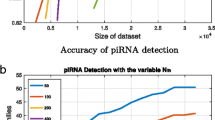Abstract
PIWI-interacting RNAs (piRNAs) are endogenously originated predominantly germline oriented newly described class of small non-coding RNAs or transcripts. piRNAs are found to be crucial ones in rendering translational arrest of proteins thereby protecting the genome germline integrity from invasive transposable elements. piRNAs are demanding more attention because of its potential role in the process of spermatogenesis and male infertility. Though there exist several computational approaches to predict piRNA sequences, a parameter based piRNA prediction strategy was not attempted yet. Understanding this scenario, a comprehensive computational schema has been developed based on Bayes and Tree classifiers. The proposed method provides an integrated platform to analyze, predict and visualize piRNA dataset from other noncoding RNAs in a multi-threaded environment. Moreover, a comparative study of different classification algorithms applicable to piRNA predictions is presented here.
Access this chapter
Tax calculation will be finalised at checkout
Purchases are for personal use only
Similar content being viewed by others
References
Betal, D., Sheridan, R., Mark, S.D., Sander, C.: Computational analysis of mouse piRNA sequence and biogenesis. PLoS Comput. Biol. 3, e222 (2007)
Zhang, Y., Wang, X., Kang, L.: A k-mer scheme to predict piRNAs and characterize locust piRNAs. Bioinformatics 27, 771–776 (2011)
Wang, K., Liang, C., Liu, J., Xiao, H., Huang, S., Xu, J., Li, F.: Prediction of piRNAs using transposon interaction and a support vector machine. BMC Bioinform. 15, 419 (2014)
Brayet, J., Zehraoui, F., Jeanson-Leh, L., Israeli, D., Tahi, F.: Towards a piRNA prediction using multiple kernel fusion and support vector machine. Bioinformatics 30, i364–i370 (2014)
Rosenkranz, D., Zischler, H.: proTRAC—a software for probabilistic piRNA cluster detection, visualization and analysis. BMC Bioinform. 13, 5 (2012)
Lakshmi, S.S., Agrawal, S.: piRNABank: a web resource on classified and clustered Piwi-interacting RNAs. Nucleic Acids Res. 36, D173–D177 (2008)
Nussinov, R., Jacobson, A.B.: Fast algorithm for predicting the secondary structure of single-stranded RNA. Proc. Natl. Acad. Sci. U.S.A. 77, 6309–6313 (1980)
Darty, K., Denise, A., Ponty, Y.: VARNA: interactive drawing and editing of the RNA secondary structure. Bioinformatics 25, 1974–1975 (2009)
Frellsen, J., Moltke, I., Thiim, M., Mardia, K.V., Ferkinghoff-Borg, J., Hamelryck, T.: A probabilistic model of RNA conformational space. PLoS Comput. Biol. 5, e1000406 (2009)
Acknowledgements
This study received funding from Kerala State Council for Science, Technology and Environment (KSCSTE). The authors thank Dr. Achuthsankar S. Nair, Head, Department of Computational Biology and Bioinformatics, University of Kerala for all kind of advice and support during the time of this work.
Author information
Authors and Affiliations
Corresponding author
Editor information
Editors and Affiliations
Rights and permissions
Copyright information
© 2015 Springer International Publishing Switzerland
About this paper
Cite this paper
Rahiman, A.A., Ajitha, J., Chandra, V. (2015). An Integrated Computational Schema for Analysis, Prediction and Visualization of piRNA Sequences. In: Huang, DS., Bevilacqua, V., Premaratne, P. (eds) Intelligent Computing Theories and Methodologies. ICIC 2015. Lecture Notes in Computer Science(), vol 9225. Springer, Cham. https://doi.org/10.1007/978-3-319-22180-9_75
Download citation
DOI: https://doi.org/10.1007/978-3-319-22180-9_75
Published:
Publisher Name: Springer, Cham
Print ISBN: 978-3-319-22179-3
Online ISBN: 978-3-319-22180-9
eBook Packages: Computer ScienceComputer Science (R0)




